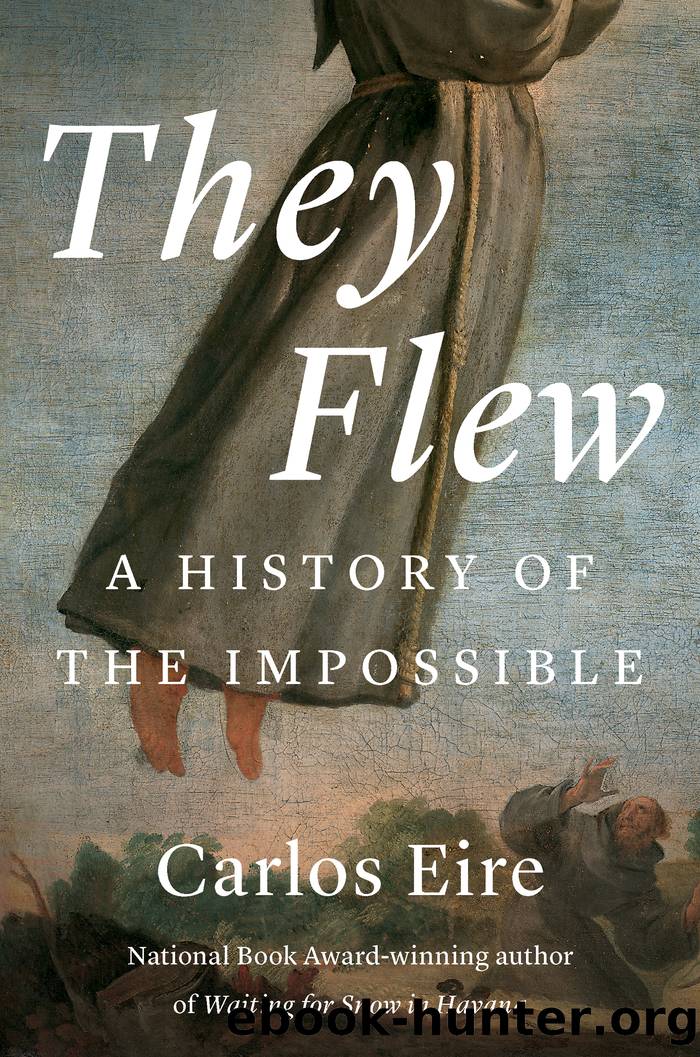They Flew by Carlos M. N. Eire;

Author:Carlos M. N. Eire;
Language: eng
Format: epub
Publisher: Yale University Press
Published: 2023-11-15T00:00:00+00:00
PART THREE
Malevolent
Angels can perform prodigies, they cannot perform miracles.
âSaint Thomas Aquinas, Quaestiones Disputatae de Potentia Dei
8. Tricksters of the Impossible
A nun who meddles in politics cannot be a saint.
âKing Philip II of Spain
Too much of a good thing, as everyone knows, can be bad. Especially too much of the miraculous, for when the impossible becomes constantly possible, the boundary between the sacred and the mundane can easily blur, divine splendor can dwindle, and the awesome can become banal, or even trivial. Worse yet, when belief in the possibility of the impossible reaches fever pitch, posing as a miracle-worker can become easier and may be a tempting option for attention seekers and tricksters. And discerning the difference between the natural and the supernatural or between genuine and fraudulent miracle claims can become immensely difficult, if not impossible, for the clerical elites in charge of ensuring the purity of the faith, as well as for the laity, including crowned monarchs. Inevitably, given the devilâs reputation as the ultimate tricksterâthe fact that he was âa liar and the father of lies,â1 ever eager to cause troubleâhe, too, could more easily wheedle his way into the picture.
Such was the dilemma faced by early modern Catholicism when miracles became a highly valued feature of Catholic identity as well as a polemical weapon to wield against Protestants and skeptics of all stripes. It was a vexing conundrum, and a painful one, for it required doubting, and doubt always rubs faith raw. Sorting the genuinely divine from the fraudulent or demonic was an ordeal that also required intellectual, emotional, psychological, and spiritual fortitude on the part of all involved in the process. Teresa of Avila, Joseph of Cupertino, and MarÃa de Ãgreda were liminal avatars of the impossible, suspended between the divine and demonic, their sanctity revered and questioned simultaneously, perfectly poised to play the role of tricksters acting as agents of the devil, the ultimate trickster.2 All three bore the brunt of doubt and survived their ordeal. But many other liminal âliving saintsâ who claimed similar impossible feats did not survive intense scrutiny. We will never know how many, exactly, since so many of the Inquisitionâs records have been lost, but it is undeniable that in the surviving records, those found guilty of fraud or diabolical mischief do outnumber those who were not. Consequently, to fully understand the context in which belief in impossible feats was forged, one must also consider cases of ostensibly holy individuals whose impossible feats failed to be recognized as genuinely divine; that is, one must take into account cases in which doubt and reason trumped faith. Cases of failure, therefore, can shed light on the larger questions that lurked behind belief in impossible miracles, and they can also help reveal how the boundaries of belief were drawn in a contentious age. Additionally, failures add texture and depth to both narrative and analysis, allowing us to pay attention to structural issues, such as negotiations of status, relations between elites and subalterns, issues
Download
This site does not store any files on its server. We only index and link to content provided by other sites. Please contact the content providers to delete copyright contents if any and email us, we'll remove relevant links or contents immediately.
The 5 Love Languages: The Secret to Love That Lasts by Gary Chapman(8527)
The Space Between by Michelle L. Teichman(6098)
Assassin’s Fate by Robin Hobb(5254)
Wiseguy by Nicholas Pileggi(4601)
Everything Happens for a Reason by Kate Bowler(4076)
Gerald's Game by Stephen King(3927)
A Simplified Life by Emily Ley(3579)
The Power of Positive Thinking by Norman Vincent Peale(3461)
Pillow Thoughts by Courtney Peppernell(3414)
Resisting Happiness by Matthew Kelly(2891)
Girl, Wash Your Face by Rachel Hollis(2828)
Being Aware of Being Aware by Rupert Spira(2711)
Name Book, The: Over 10,000 Names--Their Meanings, Origins, and Spiritual Significance by Astoria Dorothy(2496)
Real Sex by Lauren F. Winner(2480)
More Language of Letting Go: 366 New Daily Meditations by Melody Beattie(2456)
The Holy Spirit by Billy Graham(2425)
Fast Facts on Defending Your Faith by John Ankerberg & John Weldon(2394)
Victory over the Darkness by Neil T. Anderson(2389)
The Secret Power of Speaking God's Word by Joyce Meyer(2257)
